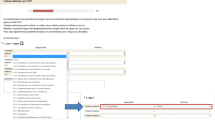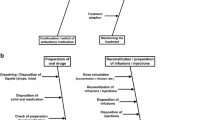Abstract
Background Although many people are involved in the optimal use of a medication within this process, the use of medications carries risks of adverse events, which are greater in the pediatric population because of many factors. Objective In this context, our aim was to develop a consensus-based list of criteria for the safety of the pediatric medication-use process or circuit (referred to from now on as the CIRCUS tool: CIRcuit-of-Child-drug-USe). Setting Multicenter with a trio of experts from eight university hospitals. Methods A literature search (1998–2013) was conducted in order to identify the different safety practice domains for the pediatric medication use process. Twenty-six safety practice domains were identified and 48 compliance criteria were formulated. In order to reach a consensus on the most relevant compliance criteria for safety practices, an international 24 French-speaking multidisciplinary panelists (8 doctors, 8 pharmacists and 8 nurses) selected to represent a broad range of experience levels and specialties took part in a two round Delphi survey which was conducted between March and July 2013. Each panelist was asked to rate each proposed criterion on a 1–9 Likert scale in order to show their level of agreement (i.e. 1 reflects strong disagreement and 9 reflects strong agreement). Main outcome measure Development of a consensus-base list for safety practices in pediatrics. Results Twenty-two of the 24 professionals invited to take part in this survey (92 % participation rate) completed the two Delphi rounds. At the end of the two Delphi rounds, a total of 38/48 (79 %) safety practice compliance criteria achieved consensus by the panelists. The criteria were grouped into 23 domains. Conclusion This study presents the development of a self-assessment tool for safety practices in the pediatric drug-use process using a Delphi method. This tool may be used in order to record and compare the prevalence of best safety practices in the pediatric drug-use process.

Similar content being viewed by others
References
World Health Organization. The high 5 s project: interim report. Geneva: World health Organization press; Dec 2013 [cited 22 March 2015]. http://www.who.int/patientsafety/implementation/solutions/high5s/High5_InterimReport.pdf?ua=1.
Direction general de l’offre des soins. DGOS CIRCULAR No. DGOS/PF2/2012/72 of 14 February 2012 on management of the quality of medicines care in health facilities. Paris: French Ministry for Work, Employment and Health; 2012 Feb 14 [cited 22 March 2015]. http://circulaire.legifrance.gouv.fr/pdf/2012/02/cir_34700.pdf.
Minister of Labour, Employment and Health and the Secretary of State. Order of 6 April 2011 on the on management of the quality of medicines care in health facilities. Paris: French Ministry for Work, Employment and Health; 2011 April 6 [cited 22 March 2015]. Available from: http://www.legifrance.gouv.fr/affichTexte.do?cidTexte=JORFTEXT000023865866&dateTexte=&categorieLien=id.
Institute for Safe Medication Practice. ISMP Medication Safety Self Assessment® for Hospitals. Horsham, PA: Institute for Safe Medication Practice; 2011 [cited 22 March 2015]. https://ismp.org/selfassessments/Hospital/2011/full.pdf.
Sharek PJ, Classen D. The incidence of adverse events and medical error in pediatrics. Pediatr Clin North Am. 2006;53(6):1067–77.
Snijders C, van Lingen RA, Molendijk A, Fetter WP. Incidents and errors in neonatal intensive care: a review of the literature. Arch Dis Child Fetal Neonatal Ed. 2007;92(5):F391–8.
Snijders C, van Lingen RA, Molendijk A, Fetter WP. Incidence and nature of medication errors in neonatal intensive care with strategies to improve safety: a review of the current literature. Drug Saf. 2007;30(6):503–13.
Kaushal R, Bates DW, Landrigan C, McKenna KJ, Clapp MD, Federico F, et al. Medication errors and adverse drug events in pediatric inpatients. JAMA. 2001;285:2114–20.
Gonzales K. Medication administration errors and the pediatric population: a systematic search of the literature. J Pediatr Nurs. 2010;25(6):555–65.
Otero P, Leyton A, Mariani G, Ceriani Cernadas JM, Patient Safety Committee. Medication errors in pediatric inpatients: prevalence and results of a prevention program. Pediatrics. 2008;122(3):e737–43.
American Society of Health-System Pharmacists. Policies and position guidelines. Bethesda, MD: American Society of Health-System Pharmacists; [updated 2015; cited 22 March 2015]. http://www.ashp.org/menu/PracticePolicy/PolicyPositionsGuidelinesBestPractices.aspx.
American College of Clinical Pharmacy. Standards of practice for clinical pharmacists. Pharmacotherapy. 2014;34(8):794–7.
Canadian Society of Hospital Pharmacists. Official publications. Ottawa, ON: Canadian Society of Hospital Pharmacists [updated 2015; cited 22 March 2015]. http://www.cshp.ca/productsServices/officialPublications/home_e.asp.
European Association of Hospital Pharmacists. Practice and policy. Hospital pharmacy practice. Brussels, BE: European Association of Hospital Pharmacists [updated 18 Feb 2015; cited 22 March 2015]. http://www.eahp.eu/practice-and-policy/hospital-pharmacy.
Miller MR, Robinson KA, Lubomski LH, Rinke ML, Pronovost PJ. Medication errors in pediatric care: a systematic review of epidemiology and an evaluation of evidence supporting reduction strategy recommendations. Qual Saf Health Care. 2007;16(2):116–26.
Mehndiratta S. Strategies to reduce medication errors in pediatric ambulatory settings. J Postgrad Med. 2012;58(1):47–53.
Dickinson CJ, Wagner DS, Shaw BE, Owens TA, Pasko D, Niedner MF. A systematic approach to improving medication safety in a pediatric intensive care unit. Crit Care Nurs Q. 2012;35(1):15–26.
van Rosse F, Maat B, Rademaker CM, van Vught AJ, Egberts AC, Bollen CW. The effect of computerized physician order entry on medication prescription errors and clinical outcome in pediatric and intensive care: a systematic review. Pediatrics. 2009;123(4):1184–90.
Johnson KB, Lee CK, Spooner SA, Davison CL, Helmke JS, Weinberg ST. Automated dose-rounding recommendations for pediatric medications. Pediatrics. 2011;128(2):e422–8.
Raju TN, Suresh G, Higgins RD. Patient safety in the context of neonatal intensive care: research and educational opportunities. Pediatr Res. 2011;70(1):109–15.
Shield T, Campbell S, Rogers A, Worrall A, Chew-Graham C, Gask L. Quality indicators for primary care mental health services. Qual Saf Health Care. 2003;12:100–6.
Gill FJ, Leslie GD, Grech C, Latour JM. Using a web-based survey tool to undertake a Delphi study: application for nurse education research. Nurse Educ Today. 2013;33(11):1322–8.
Wong IC, Wong LY, Cranswick NE. Minimising medication errors in children. Arch Dis Child. 2009;94(2):161–4.
Ghaleb MA, Barber N, Franklin BD, Yeung VW, Khaki ZF, Wong IC. Systematic review of medication errors in pediatric patients. Ann Pharmacother. 2006;40(10):1766–76.
Langerová P, Vrtal J, Urbánek K. Incidence of unlicensed and off-label prescription in children. Ital J Pediatr. 2014;4(40):12. doi:10.1186/1824-7288-40-12.
Haslund-Krog S, Mathiasen R, Christensen HR, Holst H. The impact of legislation on drug substances used off-label in paediatric wards—a nationwide study. Eur J Clin Pharmacol. 2014;70(4):445–52.
Institute for heathcare improvement. High alert medications require heightened vigilance. Cambridge, MA: Institute for Healthcare Improvement [cited 22 March 2015]. http://www.ihi.org/resources/Pages/ImprovementStories/HighAlertMedsHeightenedVigilance.aspx.
Sanghera N, Chan PY, Khaki ZF, Planner C, Lee KK, Cranswick NE, et al. Interventions of hospital pharmacists in improving drug therapy in children: a systematic literature review. Drug Saf. 2006;29(11):1031–47.
Pharmaceutical Practice Research Unit. Impact Pharmacie. Montreal, QC: Pharmaceutical Practice Research Unit; 1 Oct 2013 [updated 15 Feb 2015; cited 22 March 2015]. http://impactpharmacie.org/synthese.asp?TLien=Synthese&Valeur=ped.
Simpson JH, Lynch R, Grant J, Alroomi L. Reducing medication errors in the neonatal intensive care unit. Arch Dis Child Fetal Neonatal Ed. 2004;89:480–2.
Acknowledgments
We would like to thank the participants in the professional panel from the hospitals involved.
Funding
The authors declare that they did not receive funding for this work.
Conflicts of interest
The authors declare that they have no competing interests for this work.
Author information
Authors and Affiliations
Corresponding author
Rights and permissions
About this article
Cite this article
Guérin, A., Bussières, J.F., Boulkedid, R. et al. Development of a consensus-base list of criteria for prescribing medication in a pediatric population. Int J Clin Pharm 37, 883–894 (2015). https://doi.org/10.1007/s11096-015-0139-7
Received:
Accepted:
Published:
Issue Date:
DOI: https://doi.org/10.1007/s11096-015-0139-7




